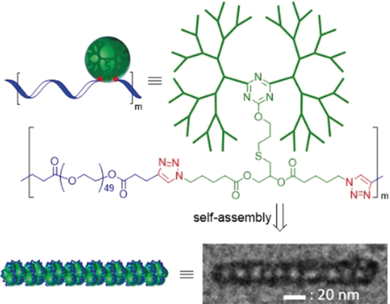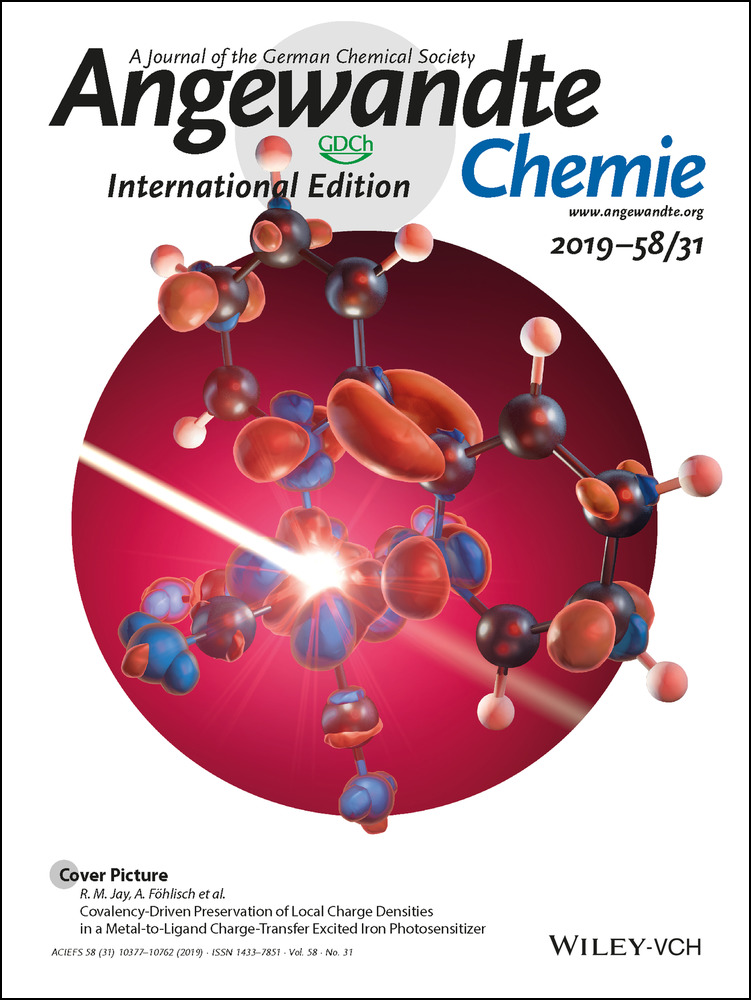Linear-Dendritic Alternating Copolymers
Haotian Sun
Department of Chemical and Biological Engineering, University at Buffalo, The State University of New York, Buffalo, NY, 14260 USA
Search for more papers by this authorFarihah M. Haque
Department of Chemistry, Tulane University, New Orleans, LA, 70118 USA
Search for more papers by this authorYi Zhang
Department of Chemical and Biological Engineering, University at Buffalo, The State University of New York, Buffalo, NY, 14260 USA
Search for more papers by this authorAlex Commisso
Department of Chemical and Biological Engineering, University at Buffalo, The State University of New York, Buffalo, NY, 14260 USA
Search for more papers by this authorMohamed Alaa Mohamed
Department of Chemical and Biological Engineering, University at Buffalo, The State University of New York, Buffalo, NY, 14260 USA
Department of Chemistry, Mansoura University, Mansoura, 35516 Egypt
Search for more papers by this authorProf. Marina Tsianou
Department of Chemical and Biological Engineering, University at Buffalo, The State University of New York, Buffalo, NY, 14260 USA
Search for more papers by this authorProf. Honggang Cui
Department of Chemical & Biomolecular Engineering, The Johns Hopkins University, Baltimore, MD, 21218 USA
Search for more papers by this authorProf. Scott M. Grayson
Department of Chemistry, Tulane University, New Orleans, LA, 70118 USA
Search for more papers by this authorCorresponding Author
Prof. Chong Cheng
Department of Chemical and Biological Engineering, University at Buffalo, The State University of New York, Buffalo, NY, 14260 USA
Search for more papers by this authorHaotian Sun
Department of Chemical and Biological Engineering, University at Buffalo, The State University of New York, Buffalo, NY, 14260 USA
Search for more papers by this authorFarihah M. Haque
Department of Chemistry, Tulane University, New Orleans, LA, 70118 USA
Search for more papers by this authorYi Zhang
Department of Chemical and Biological Engineering, University at Buffalo, The State University of New York, Buffalo, NY, 14260 USA
Search for more papers by this authorAlex Commisso
Department of Chemical and Biological Engineering, University at Buffalo, The State University of New York, Buffalo, NY, 14260 USA
Search for more papers by this authorMohamed Alaa Mohamed
Department of Chemical and Biological Engineering, University at Buffalo, The State University of New York, Buffalo, NY, 14260 USA
Department of Chemistry, Mansoura University, Mansoura, 35516 Egypt
Search for more papers by this authorProf. Marina Tsianou
Department of Chemical and Biological Engineering, University at Buffalo, The State University of New York, Buffalo, NY, 14260 USA
Search for more papers by this authorProf. Honggang Cui
Department of Chemical & Biomolecular Engineering, The Johns Hopkins University, Baltimore, MD, 21218 USA
Search for more papers by this authorProf. Scott M. Grayson
Department of Chemistry, Tulane University, New Orleans, LA, 70118 USA
Search for more papers by this authorCorresponding Author
Prof. Chong Cheng
Department of Chemical and Biological Engineering, University at Buffalo, The State University of New York, Buffalo, NY, 14260 USA
Search for more papers by this authorGraphical Abstract
Spaced-out dendrons: Step-growth “click” polymerization using well-defined linear polymeric and dendritic reactants has led to linear-dendritic copolymers in which the linear segments serve as uniform spacers between the dendrons. With alternating hydrophilic linear blocks and hydrophobic dendrons, the copolymers can spontaneously self-assemble into a unique type of microphase-segregated nanorod in water.
Abstract
Herein, the design, synthesis, and characterization of an unprecedented copolymer consisting of alternating linear and dendritic segments is described. First, a 4th-generation Hawker-type dendron with two azide groups was synthesized, followed by a step-growth azide-alkyne “click” reaction between the 4th-generation diazido dendron and poly(ethylene glycol) diacetylene to create the target polymers. Unequal reactivity of the functional groups was observed in the step-growth polymerization. The resulting copolymers, with alternating hydrophilic linear and hydrophobic dendritic segments, can spontaneously associate into a unique type of microphase-segregated nanorods in water.
Supporting Information
As a service to our authors and readers, this journal provides supporting information supplied by the authors. Such materials are peer reviewed and may be re-organized for online delivery, but are not copy-edited or typeset. Technical support issues arising from supporting information (other than missing files) should be addressed to the authors.
| Filename | Description |
|---|---|
| anie201903402-sup-0001-misc_information.pdf2.6 MB | Supplementary |
Please note: The publisher is not responsible for the content or functionality of any supporting information supplied by the authors. Any queries (other than missing content) should be directed to the corresponding author for the article.
References
- 1X. Zhu, Y. Zhou, D. Yan, J. Polym. Sci. Part B 2011, 49, 1277–1286.
- 2
- 2aD. A. Tomalia, Prog. Polym. Sci. 2005, 30, 294–324;
- 2bG. R. Newkome, E. He, C. N. Moorefield, Chem. Rev. 1999, 99, 1689–1746;
- 2cS. M. Grayson, J. M. J. Fréchet, Chem. Rev. 2001, 101, 3819–3868;
- 2dD. Astruc, L. Liang, A. Rapakousiou, J. Ruiz, Acc. Chem. Res. 2012, 45, 630–640;
- 2eK. L. Killops, L. M. Campos, C. J. Hawker, J. Am. Chem. Soc. 2008, 130, 5062–5064.
- 3
- 3aD. Astruc, E. Boisselier, C. Ornelas, Chem. Rev. 2010, 110, 1857–1959;
- 3bE. Marchi, M. Baroncini, G. Bergamini, J. V. Heyst, F. Vögtle, P. Ceroni, J. Am. Chem. Soc. 2012, 134, 15277–15280;
- 3cM. Calderón, M. A. Quadir, S. K. Sharma, R. Haag, Adv. Mater. 2010, 22, 190–218;
- 3dD. Appelhans, B. Klajnert-Maculewicz, A. Janaszewska, J. Lazniewska, B. Voit, Chem. Soc. Rev. 2015, 44, 3968–3996;
- 3eL. Röglin, E. H. Lempens, E. W. Meijer, Angew. Chem. Int. Ed. 2011, 50, 102–112; Angew. Chem. 2011, 123, 106–117.
- 4
- 4aI. Gitsov, J. Polym. Sci. Part A 2008, 46, 5295–5314;
- 4bF. Wurm, H. Frey, Prog. Polym. Sci. 2011, 36, 1–52;
- 4cO. C. J. Andrén, Y. Zhang, P. Lundberg, C. J. Hawker, A. M. Nyström, A. M. Malkoch, Chem. Mater. 2017, 29, 3891–3898;
- 4dA. Sousa-Herves, R. Riguera, E. Fernandez-Megia, New J. Chem. 2012, 36, 205–210;
- 4eY. Zhong, K. Goltsche, L. Cheng, F. Xie, F. Meng, C. Deng, Z. Zhong, R. Haag, Biomaterials 2016, 84, 250–261;
- 4fM. Yin, K. Ding, R. A. Gropeanu, J. Shen, R. D. Berger, T. Weil, K. Müllen, Biomacromolecules 2008, 9, 3231–3238.
- 5
- 5aI. Gitsov, K. L. Wooley, C. J. Hawker, P. T. Ivanova, J. M. J. Fréchet, Macromolecules 1993, 26, 5621–5627;
- 5bI. Gitsov, K. L. Wooley, J. M. J. Fréchet, Angew. Chem. Int. Ed. Engl. 1992, 31, 1200–1202; Angew. Chem. 1992, 104, 1282–1285.
- 6
- 6aT. M. Chapman, G. L. Hillyer, E. J. Mahan, K. A. Shaffer, J. Am. Chem. Soc. 1994, 116, 11195–11196;
- 6bJ. Iyer, K. Fleming, P. T. Hammond, Macromolecules 1998, 31, 8757–8765;
- 6cJ. C. M. van Hest, D. A. P. Delnoye, M. W. P. L. Baars, M. H. P. van Genderen, E. W. Meijer, Science 1995, 268, 1592–1595;
- 6dI. Gitsov, P. T. Ivanova, J. M. J. Fréchet, Macromol. Rapid Commun. 1994, 15, 387–393.
- 7
- 7aC. C. Lee, E. R. Gillies, M. E. Fox, S. J. Guillaudeu, J. M. J. Fréchet, E. E. Dy, F. C. Szoka, Proc. Natl. Acad. Sci. USA 2006, 103, 16649–16654;
- 7bR. C. Hedden, B. J. Bauer, A. P. Smith, F. Grohn, E. Amis, Polymer 2002, 43, 5473–5481.
- 8
- 8aA. D. Schlüter, A. Halperin, M. Kröger, D. Vlassopoulos, G. Wegner, B. Zhang, ACS Macro Lett. 2014, 3, 991–998;
- 8bH. Frauenrath, Prog. Polym. Sci. 2005, 30, 325–384;
- 8cY. Zhang, X. Li, G. Deng, Y. Chen, Macromol. Chem. Phys. 2006, 207, 1394–1403;
- 8dY. Shi, W. Zhu, Y. Chen, Macromolecules 2013, 46, 2391–2398.
- 9
- 9aC. J. Hawker, J. M. J. Fréchet, Polymer 1992, 33, 1507–1511;
- 9bA. Krebs, B. Bruchmann, A. Müller-Cristadoro, R. Al-Hellani, A. D. Schlüter, J. Polym. Sci. Part A 2013, 51, 1372–1377.
- 10
- 10aF. Wurm, H. Schule, H. Frey, Macromolecules 2008, 41, 9602–9611;
- 10bB. M. Rosen, C. J. Wilson, D. A. Wilson, M. Peterca, M. R. Imam, V. Percec, Chem. Rev. 2009, 109, 6275–6540;
- 10cJ. del Barrio, L. Oriol, C. Sánchez, J. L. Serrano, A. Di Cicco, P. Keller, M.-H. Li, J. Am. Chem. Soc. 2010, 132, 3762–3769.
- 11
- 11aH. C. Kolb, M. G. Finn, K. B. Sharpless, Angew. Chem. Int. Ed. 2001, 40, 2004–2021;
10.1002/1521-3773(20010601)40:11<2004::AID-ANIE2004>3.0.CO;2-5 CAS PubMed Web of Science® Google ScholarAngew. Chem. 2001, 113, 2056–2075;
- 11bM. Meldal, C. W. Tornøe, Chem. Rev. 2008, 108, 2952–3015;
- 11cC. Wang, D. Ikhlef, S. Kahlal, J.-Y. Saillard, D. Astruc, Coord. Chem. Rev. 2016, 316, 1–20;
- 11dP. Wu, A. K. Feldman, A. K. Nugent, C. J. Hawker, A. Scheel, B. Voit, J. Pyun, J. M. J. Fréchet, K. B. Sharpless, V. V. Fokin, Angew. Chem. Int. Ed. 2004, 43, 3928–3932; Angew. Chem. 2004, 116, 4018–4022.
- 12
- 12aP. L. Golas, K. Matyjaszewski, Chem. Soc. Rev. 2010, 39, 1338–1354;
- 12bA. Qin, J. W. Y. Lam, B. Z. Tang, Chem. Soc. Rev. 2010, 39, 2522–2544;
- 12cC. Deraedt, A. Rapakousiou, Y. Wang, L. Salmon, M. Bousquet, D. Astruc, Angew. Chem. Int. Ed. 2014, 53, 8445–8449; Angew. Chem. 2014, 126, 8585–8589.
- 13
- 13aN. V. Tsarevsky, B. S. Sumerlin, K. Matyjaszewski, Macromolecules 2005, 38, 3558–3561;
- 13bW. Wang, T. Li, T. Yu, F. Zhu, Macromolecules 2008, 41, 9750–9754;
- 13cS. E. Grieshaber, B. A. Paik, S. Bai, K. L. Kiick, X. Jia, Soft Matter 2013, 9, 1589–1599.
- 14C. E. Hoyle, C. N. Bowman, Angew. Chem. Int. Ed. 2010, 49, 1540–1573; Angew. Chem. 2010, 122, 1584–1617.
- 15Y. J. Li, J. N. Hoskins, S. G. Sreerama, S. M. Grayson, Macromolecules 2010, 43, 6225–6228.
- 16Y. Yu, J. Zou, L. Yu, W. Ji, Y. Li, W.-C. Law, C. Cheng, Macromolecules 2011, 44, 4793–4800.
- 17B. A. Laurent, S. M. Grayson, J. Am. Chem. Soc. 2006, 128, 4238–4239.
- 18
- 18aC. Deraedt, N. Pinaud, D. Astruc, J. Am. Chem. Soc. 2014, 136, 12092–12098;
- 18bY. Shi, R. W. Graff, X. Cao, X. Wang, H. Gao, Angew. Chem. Int. Ed. 2015, 54, 7631–7635; Angew. Chem. 2015, 127, 7741–7745;
- 18cJ.-Q. Chen, L. Xiang, X. Liu, X. Liu, K. Zhang, Macromolecules 2017, 50, 5790–5797.
- 19M. J. Robb, L. A. Connal, B. F. Lee, N. A. Lynd, C. J. Hawker, Polym. Chem. 2012, 3, 1618–1628.
- 20J. S. Trent, J. I. Scheinbeim, P. R. Couchman, Macromolecules 1983, 16, 589–598.
- 21A. R. West, Solid State Chemistry and Its Applications, 2nd ed., Wiley, Chichester, 2014.





